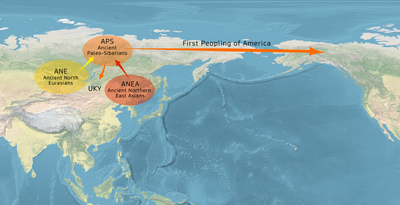
Search
Ancient Paleo-Siberian

In archaeogenetics, the term Ancient Paleo-Siberian is the name given to an ancestral component that represents the lineage of the hunter-gatherer people of the 15th-10th millennia before present, in northern and northeastern Siberia. The Ancient Paleo-Siberian population is thought to have arisen from an Ancient East Asian lineage, which diverged from other East Asian populations sometimes between 26kya to 36kya, and subsequently came into contact and merged with the Ancient North Eurasians (ANE) sometimes between 20kya to 25kya. The source for the East Asian component among Ancient Paleo-Siberians is to date best represented by Ancient Northern East Asian populations from the Amur region older than 13,000 years, such as AR19K and AR14K, and before the Devil's Cave Ancient Northeast Asian specimens.
The Ancient Paleo-Siberians are mainly defined by two human archaeological specimens: the 14,000-year-old Ust-Kyakhta-3 (UKY) individual found near Lake Baikal in southern Siberia, and the 9-10,000-year-old Kolyma_M individual found in northeastern Siberia. Specifically, the Lake Baikal Ust'Kyakhta-3 (UKY) specimen (14,050-13,770 BP) was a mixture of 30% ANE ancestry and 70% East Asian ancestry. The Ancient Paleo-Siberians are closely related to modern far-northeastern Siberia communities, such as the Koryaks, and to Native Americans. Ancestral Native Americans originated from a similar admixture event as Ancient Paleo-Siberians, carrying c. 67% East Asian-related ancestry and 33% ANE ancestry.
Technologically, Ancient Paleo-Siberians have been associated with microblade technologies and post-Last Glacial Maximum mammoth hunting.
Ancient Paleo-Siberians, in conjunction with an Inner Northeast Asian (Yumin-like) lineage, gave rise to the Cisbaikal_LNBA ancestry, which may be associated with ancient Yeniseian speakers. Ancient Paleo-Siberians also formed the dominant ancestral source for Altai hunter-gatherers (7500BP), in conjunction with a Botai-like source, as well as for the subsequent Okunevo culture, in conjunction with additional Baikal hunter-gatherer and Afanasievo-like sources.
They were later largely replaced by waves of Neo-Siberians and Neolithic Amur populations, which may be associated with the expansion of early Turkic, Mongolic, and Tungusic speakers, as well as possibly early Yukaghir and Uralic speakers (c. 7–11 kya).
See also
- Indigenous peoples of Siberia
- Paleosiberian languages
References
Sources
- Zhang, Fan (November 2021). "The genomic origins of the Bronze Age Tarim Basin mummies". Nature. 599 (7884): 256–261. Bibcode:2021Natur.599..256Z. doi:10.1038/s41586-021-04052-7. ISSN 1476-4687. PMC 8580821. PMID 34707286.
- Sikora, Martin (June 2019). "The population history of northeastern Siberia since the Pleistocene". Nature. 570 (7760): 182–188. Bibcode:2019Natur.570..182S. doi:10.1038/s41586-019-1279-z. hdl:1887/3198847. ISSN 1476-4687. PMID 31168093. S2CID 174809069.
- Mao, Xiaowei (10 June 2021). "The deep population history of northern East Asia from the Late Pleistocene to the Holocene". Cell. 184 (12): 3256–3266.e13. doi:10.1016/j.cell.2021.04.040. ISSN 0092-8674. PMID 34048699. S2CID 235226413.
- Yu, He; Spyrou, Maria A.; Karapetian, Marina; Shnaider, Svetlana; et al. (June 2020). "Paleolithic to Bronze Age Siberians Reveal Connections with First Americans and across Eurasia". Cell. 181 (6): 1232–1245.e20. doi:10.1016/j.cell.2020.04.037. PMID 32437661. S2CID 218710761.
Text submitted to CC-BY-SA license. Source: Ancient Paleo-Siberian by Wikipedia (Historical)
Articles connexes
- Ancient North Eurasian
- Paleo-Siberian languages
- Ancient Northeast Asian
- Ancient Northern East Asian
- Indigenous peoples of Siberia
- Genetic history of the Indigenous peoples of the Americas
- Ainu people
- Paleo-Eskimo
- Ancient Beringian
- Jōmon people
- Yeniseian people
- Ancient DNA
- Okhotsk culture
- List of ancient oceans
- Paleo-Indians
- Peopling of the Americas
- Yeniseian languages
- Genetic history of East Asians
- Olmec colossal heads
- Microblade technology
Owlapps.net - since 2012 - Les chouettes applications du hibou


